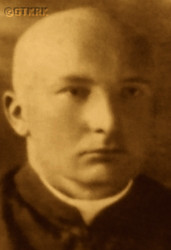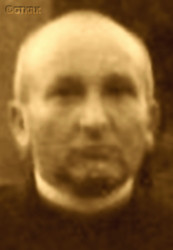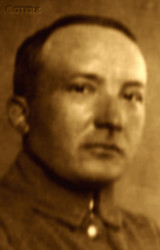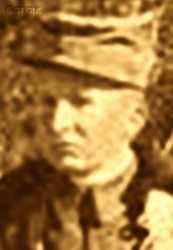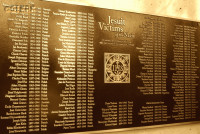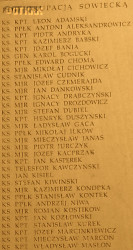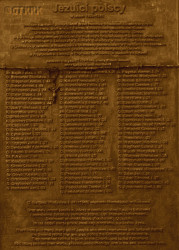Roman Catholic
St Sigismund parish
05-507 Słomczyn
85 Wiślana Str.
Konstancin deanery
Warsaw archdiocese, Poland
full list:
displayClick to display full list

searchClick to search full list by categories
wyświetlKliknij by wyświetlić pełną listę po polsku

szukajKliknij by przeszukać listę wg kategorii po polsku

Martyrology of the clergy — Poland
XX century (1914 – 1989)
personal data
surname
KONOPKA
surname
versions/aliases
NOWINA-KONOPKA
forename(s)
Casimir Stanislav (pl. Kazimierz Stanisław)
function
religious cleric
creed
Latin (Roman Catholic) Church RCmore on
en.wikipedia.org
[access: 2014.09.21]
congregation
Society of Jesus SImore on
en.wikipedia.org
[access: 2014.09.21]
(i.e. Jesuits)
diocese / province
Lesser Poland Province SI (from 1926)
Polish Province SI (1918‐1926)
Galicia Province SI (till 1918)
RC Military Ordinariate of Polandmore on
en.wikipedia.org
[access: 2014.12.20]
honorary titles
„Cross of Independence”more on
en.wikipedia.org
[access: 2019.02.02]
(16.03.1933)
„Polonia Restituta” Cross — 4th Class, Officer'smore on
en.wikipedia.org
[access: 2019.04.16]
Allied Victory Medalmore on
pl.wikipedia.org
[access: 2023.02.20]
„Cross of Valour”more on
en.wikipedia.org
[access: 2019.04.16]
date and place
of death
26.06.1941

Lvivtoday: Lviv urban hrom., Lviv rai., Lviv obl., Ukraine
more on
en.wikipedia.org
[access: 2022.01.16]
details of death
On 27.12.1915, during World War I of 1914‐1918, joined the Polish Legions, a formation of the Austro–Hungarian Imperial Army, taking up the position of chaplain of the 4th Infantry Regiment of the 3rd Brigade. The regiment — known as the „fourths” — was deployed to the front line of the battles between the Central Powers (Germany and Austria–Hungary) and Russia, in Volyn, where it ran approximately halfway between Lutsk and Rivne. Was there when the largest offensive of the Imperial Russian Army during World War I, known as the Brusilov Offensive, began on 04.06.1916. The attack brought success to the Russians, and the Central Powers owed preventing a complete defeat, among other things, to defense of the front line by the Polish Legions, including his regiment, in the Battle of Kostiuchnówka, c. 70 km north of Lutsk, on 04‐06.07.1916 — the largest and bloodiest clash on the battle trail of the Polish Legions. The offensive ended on 20.09.1916 with a partial victory of the Russians, which temporarily shifted the front line several dozen kilometers to the west (on the south, i.a. in Bukovina regiona, reaching the arc of Carpathian range). The regiment was then withdrawn from the front line (the Legions lost c. 2,000 soldiers during the battle).
The Battle of Kostiuchnówka became the starting point for a whole series of events, the common denominator of which were the efforts to establish a Polish army, independent of the Central Powers. As early as 09.07.1916, Brigadier Joseph Piłsudski resigned from commanding the Legions (accepted on 26.09.1916), expressing his opposition to the non–recognition of the Legions as the Polish army. On 20.09.1916, the Polish Legions were transformed by the Austro–Hungarian command into the Polish Auxiliary Corps PKP, with the hope of increasing the number of Polish recruits in the army of the Monarchy.
On the same day, his regiment was transferred to the 2nd Brigade (of the former Polish Legions). At the end of 11.1916, the Regiment was translocated to Warsaw, but was met with a cool reception from the capital's residents — this took place after 05.11.1916, when the Central Powers issued a proclamation containing a promise of the creation of the Kingdom of Poland, remaining in unspecified „communication with both allied powers”, i.e. another attempt to draw Poles into the army of the Central Powers. On 01.12.1916, was moved to Fort III Pomiechówek in the Modlin Fortress, and on 02.01.1917 to Łomża.
On 01.02.1917, became chaplain of the 6th Infantry Regiment within the 3rd PKP Brigade (i.e. Legions), stationed in Zajezierze near Dęblin. Earlier, on 15.01.1917, the Provisional Council of State began its activity in the promised Kingdom of Poland, established by the Central Powers occupation authorities, in which the War Department was to be headed by Joseph Piłsudski. Served in the Regiment when on 10.04.1917, Austria–Hungary, in accordance with the provisions of the act of 05.11.1916, decided to incorporate the PKP into the Germ. Polnische Wehrmacht (Eng. Polish Armed Force) created in the aforementioned Kingdom of Poland, under the command of the Governor–General of Germ. Kaiserlich–deutsche Generalgouvernement Warschau (Eng. Imperial–German General Government of Warsaw), i.e. the part of the Kingdom of Poland occupied by the Germans, Hans Hartwig von Beseler. This caused the so‐called oath crisis, when on 09.07.1917 Polish soldiers originating from the pre‐war Russian partition (known as Królewiacy), mainly from the 1st and 3rd PKP Brigades, refused — at Joseph Piłsudski's request — to take the required oath of allegiance to the Central Powers. On 21.07.1917 Joseph Piłsudski was arrested, and a month later the Provisional Council of State ceased to function. In mid‐09.1917 the 6th Infantry Regiment was disbanded, and Królewiacy — 15 officers, 410 non‐commissioned officers and privates — were interned in camps in Fort Beniaminów and Szczypiorno.
Took over then the function of chaplain of the 3rd Infantry Regiment within the 2nd PKP Brigade in the ranks of the Germ. Polnische Wehrmacht, in which approximately ⅔ of the soldiers took the aforementioned oath. On 05.10.1917 the regiment was sent from Przemyśl to the front in Bukovina, near Chernivtsi on the Prut River. Battled briefly with the Russians, after which it was moved to the rears. There, information reached the Polish units about the treaty signed on 09.02.1918 in Brest by the Central Powers with the so‐called Ukrainian People's Republic UPR — established on the territories controlled by the Russians after the fall of tsarism in 02.1917 and the Bolshevik coup in 10.1917 — which on 22.01.1918 declared of the independence of Ukraine. The information published indicated that the Central Powers, without consultations with the Poles, recognised Ukraine and granted it, among other things, the Chełm region, although Eastern Galicia, was left in the hands of Austria–Hungary. The 2nd Brigade, under the command of Colonel Joseph Haller, decided then to cross the front line to the Ukrainian side. On 15.02.1918 the Brigade, including its 3rd Regiment, broke through the Austrian troops line in the Rarańcza (Ridkivtsi) village near Chernivtsi and crossed the provisional border.
In the application for the Virtuti Militari order (it is not clear whether received it), was written: „Under the fire of rifles and artillery, crossed the Austrian trenches near Rarańcza — completed all the marches of the 2nd Brigade and the 2nd Corps”. The regiment then marched east, generally along the left bank of the Dniester, through Khotyn, Zhvanets (where it fought the Bolsheviks), Kamyanets–Podilskyi, Mohyliv to Soroca on the Dniester, where it arrived on 06.03.1918. There, it joined the emerging 2nd Polish Corps, formed from Poles — soldiers from the Russian fronts: Romanian and south–western — and from Poles in Bessarabia.
Became then the dean of the Corps and chaplain of its 4th Rifle Division. When on 28.03.1918 its command was taken over by Colonel Haller, the Corps became the only independent Polish armed formation during World War I, not subject to the command of any foreign army. Meanwhile, on 03.03.1918 in Brest, the Central Powers signed a separatist peace treaty with Bolshevik Russia, in which Russia withdrew from the war, recognising, among other things, independence of Ukraine and committing to withdraw their troops from the territory of the UPR. Immediately afterwards, German and Austro–Hungarian troops entered the UPR territory. Then the 2nd Corps withdrew eastwards and reached the Dnieper, where it stopped in the area of Kaniv.
On 11.05.1918 the Corps was attacked by the Germans. In the aforementioned application for the Virtuti Militari, „during the Battle of Kaniv, with his innate calmness, risking his life, under machine gun fire, tended to the wounded and gave them his last priestly service. This calmness of his in the performance of his duties influenced the behavior of the soldiers, who, temporarily interrupted by the sudden German attack, were slowly gathering into units”. Due to the lack of ammunition, on 12.05.1918 the Corps capitulated. The Polish soldiers were disarmed, taken prisoner, treated not as prisoners but as traitors, and then transported — via Brest — to camps and prisons deep in Germany.
Avoided arrest and reached Kiev. Supported the efforts of General Haller, who also avoided arrest, to transport soldiers of the disbanded corps to Murmansk, where it was intended to re–form Polish units and send them to France. Most were however captured by the Bolsheviks and shot on the spot. Similarly supported attempts to transfer Polish soldiers to the Kuban region, near the Caucasus. The aforementioned application for the Virtuti Military stated: „After the Battle of Kaniv, disguised as a peasant, remained on the territory of Ukraine, providing assistance to fugitive soldiers and the Polish population”.
Himself was sentenced by the Central Powers to death in absentia, but despite this made it to Zhytomyr, where lectured at the Theological Seminary under the assumed name of „Nowina”.
After the end of World War I on 11.11.1918 — on that day in the staff car in Compiègne, at the headquarters of French Marshal Ferdinand Foch, an armistice was signed between the Allies and the Central Powers, and at the same time, Brigadier Joseph Piłsudski took over the supreme authority over Polish troops in the Kingdom of Poland, becoming their commander‐in‐chief, which de facto meant the rebirth of the Polish state — chaos reigned in Ukraine, caused by, among other things, the violation of the Treaty of Brest by Bolshevik Russia and the Polish–Ukrainian War of 1918‐1919. In connection with this, the Theological Seminary in Zhytomyr was closed. Moved then to Lutsk and then to Chełm Lubelski, under Polish control.
There served during the Russian offensive in the Polish–Russian War of 1919‐1921. Was an auxiliary chaplain of the field hospital, in particular during the so‐called Battle of Chełm on 11‐18.08.1920, when Polish troops prevented the Russians from taking Chełm.
After German and Russian invasion of Poland in 09.1939 and start of the World War II, after the occupation of Lviv by the Russians began on 22.09.1939, ministered to the prisoners in Lviv prisons.
After the German attack in June 1941 on their erstwhile ally, the Russians, during the Russian genocidal prison massacres, shot by a Russian soldier in the garden of the Jesuit retreat house in Lviv that he ran (or murdered in one of the Lviv prisons).
cause of death
mass murder
perpetrators
Russians
sites and events
06.1941 massacres (NKVD)Click to display the description, Lviv (Brygidki)Click to display the description, Ribbentrop‐MolotovClick to display the description, Pius XI's encyclicalsClick to display the description, Polish‐Russian war of 1919‐1921Click to display the description
date and place
of birth
10.01.1879

Tarnówtoday: Tarnów city pov., Lesser Poland voiv., Poland
more on
en.wikipedia.org
[access: 2021.06.07]
parents
KONOPKA Leo
🞲 ?, ? — 🕆 ?, ?

KLEIN Anne
🞲 ?, ? — 🕆 ?, ?
religious vows
02.02.1914 (last)
presbyter (holy orders)
ordination
14.04.1906

Krakówtoday: Kraków city pov., Lesser Poland voiv., Poland
more on
en.wikipedia.org
[access: 2021.06.07]
positions held
1938 – 1941
friar — Lvivtoday: Lviv urban hrom., Lviv rai., Lviv obl., Ukraine
more on
en.wikipedia.org
[access: 2022.01.16] ⋄ St Joseph monastery (Retreat House), Jesuits SI — also: prison chaplain
1933 – 1938
certified teacher — Bunkovychin .Khyriv
today: Khyriv urban hrom., Sambir rai., Lviv obl., Ukraine
more on
uk.wikipedia.org
[access: 2022.11.09] ⋄ St Joseph College („Khyriv” Scientific and Educational Institute), Jesuits SI
1931 – 1933
missionary — (Northern Rhodesia territory)today: Zambia
more on
en.wikipedia.org
[access: 2022.11.09]
1923 – 1930
certified teacher — Bunkovychin .Khyriv
today: Khyriv urban hrom., Sambir rai., Lviv obl., Ukraine
more on
uk.wikipedia.org
[access: 2022.11.09] ⋄ St Joseph College („Khyriv” Scientific and Educational Institute), Jesuits SI — professor of general history and geography; also: chaplain of the correctional home in Peredilnytsya (c. 12 km from Khyriv) and of the workers of the oil mine in Ropienka (approx. 15 km from Khyriv)
1921 – 1922
director — Vilniustoday: Vilnius city dist., Vilnius Cou., Lithuania
more on
en.wikipedia.org
[access: 2022.01.06] ⋄ St Casimir the Prince Gymnasium, St Casimir the Prince and Confessor monastery, Jesuits SI
1920 – 1921
friar — Chełmtoday: Chełm city pov., Lublin voiv., Poland
more on
en.wikipedia.org
[access: 2021.08.20] ⋄ Nativity of the Blessed Virgin Mary monastery, Jesuits SI — also: prefect at a craft school and Teachers' Seminary for Women, and as a volunteer the chaplain at a military hospital; prob. in 1921 verified as the military parish pastor of the Polish Army, with seniority from 01.06.1919, in the rank of lieutenant colonel
1919 – 1920
professor — Lutsktoday: Lutsk city rai., Volyn obl., Ukraine
more on
en.wikipedia.org
[access: 2021.09.17] ⋄ history of the Polish Church, homiletics, patrology and German, Theological Seminary
c. 1919
prefect — Olykatoday: Olyka hrom., Lutsk rai., Volyn obl., Ukraine
more on
en.wikipedia.org
[access: 2021.09.17] ⋄ Holy Trinity RC collegiate parish ⋄ Dubnotoday: Dubno urban hrom., Dubno rai., Rivne obl., Ukraine
more on
en.wikipedia.org
[access: 2020.11.27] RC deanery
1918 – 1919
professor — Zhytomyrtoday: Zhytomyr urban hrom., Zhytomyr rai., Zhytomyr obl., Ukraine
more on
en.wikipedia.org
[access: 2021.09.17] ⋄ history of the Polish Church, homiletics, patrology and German, Theological Seminary — till 11.11.1918 and the fall of the Austro–Hungarian Monarchy, due to the death sentence issued in absentia by the Monarchy authorities, under the assumed name „Nowina”; also: organizer of a public library and a folk university
15.02.1918 – 12.05.1918
RC military dean — 2nd Polish Corps 2KP — also: chaplain of the 4th Rifle Division; till 06.03.1918 chaplain of the 3rd Infantry Regiment of the 2nd Brigade, which left the Central Powers and crossed over to Ukraine
10.04.1917 – 15.02.1918
RC military chaplain — Germ. Polnische Wehrmacht des Königreich Polen (Eng. Polish Armed Forces of the Kingdom of Poland), command of the Central Powers armies — of the 6th Infantry Regiment of the 3rd Brigade in the Polish Auxiliary Corps PKP (till 09.1917), of the 3rd Infantry Regiment of the 2nd Brigade in the Polish Auxiliary Corps PKP (till 15.02.1918)
12.1915 – 10.04.1917
RC military chaplain — Austro–Hungarian Imperial Army — of the 4th Infantry Regiment, i.e. „fourths”, in the 3rd Brigade of the Polish Legions LP (till 20.09.1916), 4th Infantry Regiment, i.e. „fourths”, of the 2nd Brigade in the Polish Auxiliary Corps PKP (till 11.1917), of the 6th Infantry Regiment ofn the 3rd Brigade in the Polish Auxiliary Corps PKP (till 10.04.1917); from 25.02.1916 formally a military official of the 9th class, in the rank of captain
1915
certified teacher — Dziedzicetoday: neighborhood in Czechowice‐Dziedzice, Czechowice‐Dziedzice gm., Bielsko‐Biała pov., Silesia voiv., Poland
more on
pl.wikipedia.org
[access: 2021.12.19] ⋄ Department of Theology, St Joseph monastery (Retreat House), Jesuits SI — professor of Church history and homiletics
1914 – 1915
friar — Krakówtoday: Kraków city pov., Lesser Poland voiv., Poland
more on
en.wikipedia.org
[access: 2021.06.07] ⋄ monastery, Jesuits SI — chaplain of the ophthalmology clinic
1913 – 1914
certified teacher — Krakówtoday: Kraków city pov., Lesser Poland voiv., Poland
more on
en.wikipedia.org
[access: 2021.06.07] ⋄ College (Lat. Collegium Maximum SS. Cordis Iesu, 26 Kopernik Str.), Jesuits SI — professor of Church history
1912 – 1913
Third Probation — Ternopiltoday: Ternopil urban hrom., Ternopil rai., Ternopil obl., Ukraine
more on
en.wikipedia.org
[access: 2020.11.20] ⋄ College, Immaculate Conception of the Blessed Virgin Mary monastery, Jesuits SI
1910 – 1912
certified teacher — Bunkovychin .Khyriv
today: Khyriv urban hrom., Sambir rai., Lviv obl., Ukraine
more on
uk.wikipedia.org
[access: 2022.11.09] ⋄ St Joseph College („Khyriv” Scientific and Educational Institute), Jesuits SI — professor of general history and geography
1906 – 1910
friar — Krakówtoday: Kraków city pov., Lesser Poland voiv., Poland
more on
en.wikipedia.org
[access: 2021.06.07] ⋄ monastery, Jesuits SI
1906 – 1910
student — Krakówtoday: Kraków city pov., Lesser Poland voiv., Poland
more on
en.wikipedia.org
[access: 2021.06.07] ⋄ history, Department of Philosophy, Jagiellonian University UJ
1904 – 1906
student — Krakówtoday: Kraków city pov., Lesser Poland voiv., Poland
more on
en.wikipedia.org
[access: 2021.06.07] ⋄ theology, College (Lat. Collegium Maximum SS. Cordis Iesu, 26 Kopernik Str.), Jesuits SI
1902 – 1903
friar — Bunkovychin .Khyriv
today: Khyriv urban hrom., Sambir rai., Lviv obl., Ukraine
more on
uk.wikipedia.org
[access: 2022.11.09] ⋄ monastery, St Joseph College („Khyriv” Scientific and Educational Institute), Jesuits SI — student of the last years of gymnasium
1899 – 1902
student — Nowy Sącztoday: Nowy Sącz pov., Lesser Poland voiv., Poland
more on
en.wikipedia.org
[access: 2021.04.01] ⋄ philosophy, Holy Spirit College, Jesuits SI
1896 – 1899
friar — Stara Wieśtoday: Brzozów gm., Brzozów pov., Subcarpathia voiv., Poland
more on
en.wikipedia.org
[access: 2021.12.18] ⋄ Assumption of the Blessed Virgin Mary monastery, Jesuits SI — student of the humanities gymnasium
1894 – 1896
novitiate — Stara Wieśtoday: Brzozów gm., Brzozów pov., Subcarpathia voiv., Poland
more on
en.wikipedia.org
[access: 2021.12.18] ⋄ Assumption of the Blessed Virgin Mary monastery, Jesuits SI
10.01.1894
accession — Stara Wieśtoday: Brzozów gm., Brzozów pov., Subcarpathia voiv., Poland
more on
en.wikipedia.org
[access: 2021.12.18] ⋄ Assumption of the Blessed Virgin Mary monastery, Jesuits SI
publicist in many magazines and periodicals, e.g. „General Revie”, „Catholic Voices”, „Naszych Our News”; editor of „Current News from the Galician Province” (1914‐1915), „People of God” in Lutsk (1919‐1920); author of numerous historical articles, e.g. m.in. „Queen Hedvig”, „A Christian Hero”, „The Seals of the Jesuits in Poland. A Study”, „From the Life of Catholic Missions in Rhodesia”; author of „War memoirs of the chaplain of the 2nd Brigade of the Polish Legions” (Kraków, 1993)
others related
in death
BAŁUTClick to display biography Anthony (Fr Roman), BANSZELClick to display biography Charles, BUCZYŃSKIClick to display biography Joseph, CZEMERYŃSKIClick to display biography Yaroslav Anthony, KAŹNICAClick to display biography Monica, KNYSZClick to display biography Stephen, KOWALIKClick to display biography Zeno, MARCHIEWICZClick to display biography Francis (Fr Michael), PISKOZUBClick to display biography Julia, OSIDACZClick to display biography Roman, ZAWOROTIUKClick to display biography Michael, KOWERKOClick to display biography Maximilian, STOKŁOSAClick to display biography Joseph
sites and events
descriptions
06.1941 massacres (NKVD): After German attack of Russian‐occupied Polish territory and following that of Russia itself, before a panic escape, Russians murdered — in accordance with the genocidal order issued on 24.06.1941 by the Russian interior minister Lawrence Beria to murder all prisoners (formally „sentenced” for „counter‐revolutionary activities”, „anti‐Russian acts”, sabotage and diversion, and political prisoners „in custody”), held in NKVD‐run prisons in Russian occupied Poland, Lithuania, Latvia and Estonia — c. 40,000‐50,000 prisoners. In addition Russians murdered many thousands of victims arrested after German attack regarding them as „enemies of people” — those victims were not even entered into prisons’ registers. Most of them were murdered in massacres in the prisons themselves, the others during so‐called „death marches” when the prisoners were driven out east. After Russians departure and start of German occupation a number of spontaneous pogroms of Jews took place. Many Jews collaborated with Russians and were regarded as co‐responsible for prison massacres. (more on: en.wikipedia.orgClick to attempt to display webpage
[access: 2021.12.19])
Lviv (Brygidki): Penal prison, then at 34 Kazimierzowska Str. in Lviv — in the buildings of the former monastery of the Order of St Brigid, in 1784 — after the first partition of Poland and after the dissolution of the religious orders as part of the so—called Josephine dissolutions — converted by the partitioning Austrian authorities into a prison. In 1939‐1941, the Russians held there thousands of prisoners, most of them Poles. On c. 26.06.1941, in the face of the German invasion and attack of their erstwhile ally, the Russians, during a panic escape (the left Lviv exactly on 26.06.1941), genocideally murdered several thousand prisoners. In 1941‐1944 the prison was run by the Germans and mass murders of Polish, Jewish and Ukrainian civilians took place there. After start of another Russian occupation in 1941 prison in which the executions were carried out on prisoners sentenced to death. (more on: en.wikipedia.orgClick to attempt to display webpage
[access: 2014.09.21])
Ribbentrop‐Molotov: Genocidal Russian‐German alliance pact between Russian leader Joseph Stalin and German leader Adolf Hitler signed on 23.08.1939 in Moscow by respective foreign ministers, Mr. Vyacheslav Molotov for Russia and Joachim von Ribbentrop for Germany. The pact sanctioned and was the direct cause of joint Russian and German invasion of Poland and the outbreak of the World War II in 09.1939. In a political sense, the pact was an attempt to restore the status quo ante before 1914, with one exception, namely the „commercial” exchange of the so‐called „Kingdom of Poland”, which in 1914 was part of the Russian Empire, fore Eastern Galicia (today's western Ukraine), in 1914 belonging to the Austro‐Hungarian Empire. Galicia, including Lviv, was to be taken over by the Russians, the „Kingdom of Poland” — under the name of the General Governorate — Germany. The resultant „war was one of the greatest calamities and dramas of humanity in history, for two atheistic and anti‐Christian ideologies — national and international socialism — rejected God and His fifth Decalogue commandment: Thou shall not kill!” (Abp Stanislav Gądecki, 01.09.2019). The decisions taken — backed up by the betrayal of the formal allies of Poland, France and Germany, which on 12.09.1939, at a joint conference in Abbeville, decided not to provide aid to attacked Poland and not to take military action against Germany (a clear breach of treaty obligations with Poland) — were on 28.09.1939 slightly altered and made more precise when a treaty on „German‐Russian boundaries and friendship” was agreed by the same murderous signatories. One of its findings was establishment of spheres of influence in Central and Eastern Europe and in consequence IV partition of Poland. In one of its secret annexes agreed, that: „the Signatories will not tolerate on its respective territories any Polish propaganda that affects the territory of the other Side. On their respective territories they will suppress all such propaganda and inform each other of the measures taken to accomplish it”. The agreements resulted in a series of meeting between two genocidal organization representing both sides — German Gestapo and Russian NKVD when coordination of efforts to exterminate Polish intelligentsia and Polish leading classes (in Germany called «Intelligenzaktion», in Russia took the form of Katyń massacres) where discussed. Resulted in deaths of hundreds of thousands of Polish intelligentsia, including thousands of priests presented here, and tens of millions of ordinary people,. The results of this Russian‐German pact lasted till 1989 and are still in evidence even today. (more on: en.wikipedia.orgClick to attempt to display webpage
[access: 2015.09.30])
Pius XI's encyclicals: Facing the creation of two totalitarian systems in Europe, which seemed to compete with each other, though there were more similarities than contradictions between them, Pope Pius XI issued in 03.1937 (within 5 days) two encyclicals. In the „Mit brennender Sorge” (Eng. „With Burning Concern”) published on 14.03.1938, condemned the national socialism prevailing in Germany. The Pope wrote: „Whoever, following the old Germanic‐pre‐Christian beliefs, puts various impersonal fate in the place of a personal God, denies the wisdom of God and Providence […], whoever exalts earthly values: race or nation, or state, or state system, representatives of state power or other fundamental values of human society, […] and makes them the highest standard of all values, including religious ones, and idolizes them, this one […] is far from true faith in God and from a worldview corresponding to such faith”. On 19.03.1937, published „Divini Redemptoris” (Eng. „Divine Redeemer”), in which criticized Russian communism, dialectical materialism and the class struggle theory. The Pope wrote: „Communism deprives man of freedom, and therefore the spiritual basis of all life norms. It deprives the human person of all his dignity and any moral support with which he could resist the onslaught of blind passions […] This is the new gospel that Bolshevik and godless communism preaches as a message of salvation and redemption of humanity”… Pius XI demanded that the established human law be subjected to the natural law of God , recommended the implementation of the ideal of a Christian state and society, and called on Catholics to resist. Two years later, National Socialist Germany and Communist Russia came together and started World War II. (more on: www.vatican.vaClick to attempt to display webpage
[access: 2023.05.28], www.vatican.vaClick to attempt to display webpage
[access: 2023.05.28])
Polish‐Russian war of 1919‐1921: War for independence of Poland and its borders. Poland regained independence in 1918 but had to fight for its borders with former imperial powers, in particular Russia. Russia planned to incite Bolshevik‐like revolutions in the Western Europe and thus invaded Poland. Russian invaders were defeated in 08.1920 in a battle called Warsaw battle („Vistula river miracle”, one of the 10 most important battles in history, according to some historians). Thanks to this victory Poland recaptured part of the lands lost during partitions of Poland in XVIII century, and Europe was saved from the genocidal Communism. (more on: en.wikipedia.orgClick to attempt to display webpage
[access: 2014.12.20])
sources
personal:
college.holycross.eduClick to attempt to display webpage
[access: 2012.11.23], cracovia-leopolis.plClick to attempt to display webpage
[access: 2013.01.06], www.academia.eduClick to attempt to display webpage
[access: 2013.01.13], biographies.library.nd.eduClick to attempt to display webpage
[access: 2014.05.09], archive.todayClick to attempt to display webpage
[access: 2021.12.19]
bibliographical:
„Register of Latin rite Lviv metropolis clergy’s losses in 1939‐45”, Józef Krętosz, Maria Pawłowiczowa, editors, Opole, 2005
„Biographical lexicon of Lviv Roman Catholic Metropoly clergy victims of the II World War 1939‐1945”, Mary Pawłowiczowa (ed.), Fr Joseph Krętosz (ed.), Holy Cross Publishing, Opole, 2007
original images:
www.audiovis.nac.gov.plClick to attempt to display webpage
[access: 2015.03.01], ordynariat.wp.mil.plClick to attempt to display webpage
[access: 2015.09.30], archiwum-ordynariat.wp.mil.plClick to attempt to display webpage
[access: 2024.12.13], www.audiovis.nac.gov.plClick to attempt to display webpage
[access: 2015.03.01], college.holycross.eduClick to attempt to display webpage
[access: 2013.05.19], www.katedrapolowa.plClick to attempt to display webpage
[access: 2014.01.16], www.miejscapamiecinarodowej.plClick to attempt to display webpage
[access: 2014.05.09], ipn.gov.plClick to attempt to display webpage
[access: 2019.02.02]
LETTER to CUSTODIAN/ADMINISTRATOR
If you have an Email client on your communicator/computer — such as Mozilla Thunderbird, Windows Mail or Microsoft Outlook, described at WikipediaPatrz:
en.wikipedia.org, among others — try the link below, please:
LETTER to CUSTODIAN/ADMINISTRATORClick and try to call your own Email client
If however you do not run such a client or the above link is not active please send an email to the Custodian/Administrator using your account — in your customary email/correspondence engine — at the following address:

giving the following as the subject:
MARTYROLOGY: KONOPKA Casimir Stanislav
To return to the biography press below:
 Click to return to biography
Click to return to biography








